
Milan Cathedral, or Metropolitan Cathedral-Basilica of the Nativity of Saint Mary, is the cathedral church of Milan, Lombardy, Italy. Dedicated to the Nativity of St. Mary, it is the seat of the Archbishop of Milan, currently Archbishop Mario Delpini.

Spoleto Cathedral is the cathedral of the Archdiocese of Spoleto-Norcia created in 1821, previously that of the diocese of Spoleto, and the principal church of the Umbrian city of Spoleto, in Italy. It is dedicated to the Assumption of the Blessed Virgin Mary.

Salerno Cathedral is the main church in the city of Salerno in southern Italy and a major tourist attraction. It is dedicated to Saint Matthew, whose relics are inside the crypt.

Orvieto Cathedral is a large 14th-century Roman Catholic cathedral dedicated to the Assumption of the Virgin Mary and situated in the town of Orvieto in Umbria, central Italy. Since 1986, the cathedral in Orvieto has been the episcopal seat of the former Diocese of Todi as well.
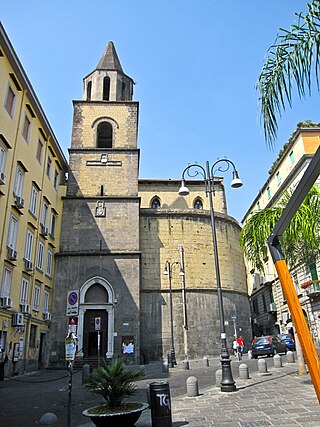
San Pietro a Majella is a church in Naples, Italy. The term may also refer to the adjacent Naples music conservatory, which occupies the premises of the monastery that used to form a single complex with the church.

Prato Cathedral, or Cathedral of Saint Stephen, is a Roman Catholic cathedral in Prato, Tuscany, Central Italy, from 1954 the seat of the Bishop of Prato, having been previously, from 1653, a cathedral in the Diocese of Pistoia and Prato. It is dedicated to Saint Stephen, the first Christian martyr.

The Cathedral of Cefalù is a Roman Catholic basilica in Cefalù, Sicily. It is one of nine structures included in the UNESCO World Heritage Site known as Arab-Norman Palermo and the Cathedral Churches of Cefalù and Monreale.

Trento Cathedral is a Roman Catholic cathedral in Trento, northern Italy. It is the mother church of the Roman Catholic Archdiocese of Trento, and until 1802, was the seat of the Prince-Bishopric of Trent. It was built over a pre-existing 4th-century church devoted to Saint Vigilius, patron saint of the city.

The chiesa di Sant'Anastasia, or the Basilica of Saint Anastasia is a church built by the Dominican Order in Verona, northern Italy. In Gothic style, it is the largest church in the city, located in its most ancient district, near the Ponte Pietra.

The Duomo of Monza, often known in English as Monza Cathedral, is the main religious building of Monza, Italy. Unlike most duomi, it is not in fact a cathedral, as Monza has always been part of the Diocese of Milan, but is in the charge of an archpriest who has the right to certain episcopal vestments including the mitre and the ring. The church is also known as the Basilica of San Giovanni Battista from its dedication to John the Baptist.

Italian Gothic architecture (also called temperate Gothic architecture, has characteristics that distinguish it considerably from those of the place of origin of Gothic architecture, France, and from other European countries in which this language has spread.
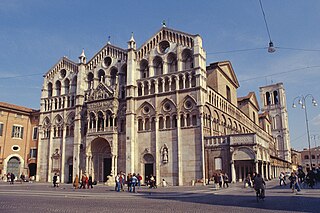
Ferrara Cathedral is a Roman Catholic cathedral and minor basilica in Ferrara, Northern Italy. Dedicated to Saint George, the patron saint of the city, it is the seat of the Archbishop of Ferrara and the largest religious building in the city.
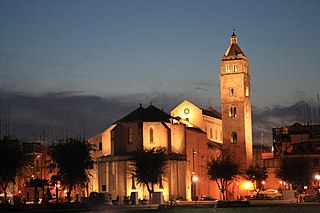
Barletta Cathedral is a Roman Catholic cathedral in Barletta, Apulia, southern Italy. Formerly the seat of the archbishops of Barletta and Nazareth, it is currently a co-cathedral in the Archdiocese of Trani-Barletta-Bisceglie. It was built in two different styles, Romanesque and Gothic, from the 12th century to the 14th century.
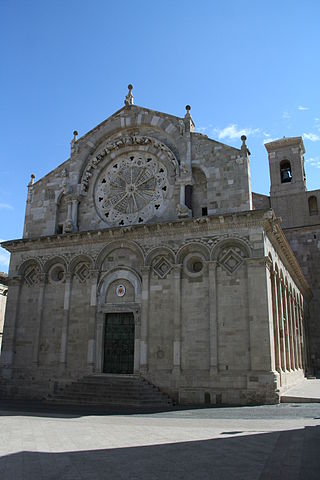
Troia Cathedral is the cathedral of Troia in Apulia, Italy, dedicated to the Assumption of the Blessed Virgin Mary. Built in the first quarter of the 12th century, it is reckoned a masterpiece of Apulian Romanesque architecture and is particularly noted for the rose window and the bronze doors of the west front. Formerly the seat of the Bishops of Troia, it is now a co-cathedral in the diocese of Lucera-Troia.

Termoli Cathedral is a Roman Catholic cathedral in Termoli, in the province of Campobasso, central Italy. The dedication is to the Purification of the Virgin Mary, but is commonly ascribed to Saints Bassus and Timothy, patrons of the city. It is the seat of the Bishop of Termoli-Larino.
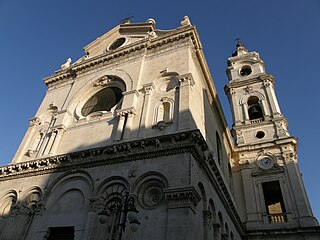
Foggia Cathedral, otherwise the Church of the Assumption of the Virgin Mary or Church of Saint Mary of Foggia, is a Roman Catholic cathedral in the city of Foggia, Italy, dedicated to the Assumption of the Virgin Mary. It is the seat of the Archbishop of Foggia-Bovino.

Monopoli Cathedral, otherwise the Basilica of the Madonna della Madia or Santa Maria della Madia is a Roman Catholic cathedral in the town of Monopoli, in the province of Bari, region of Apulia, Italy. It is dedicated to the Virgin Mary under the title of the Madonna della Madia, after an icon kept here. Formerly the episcopal seat of the Diocese of Monopoli, it has been since 1986 a co-cathedral in the Diocese of Conversano-Monopoli.

Castellaneta Cathedral is a Roman Catholic cathedral in Castellaneta, province of Taranto, Apulia, Italy, dedicated to the Assumption of the Virgin Mary. It is the episcopal seat of the Diocese of Castellaneta.

Ostuni Cathedral is a Roman Catholic cathedral in Ostuni, province of Brindisi, region of Apulia, Italy. The dedication is to the Assumption of the Virgin Mary. Formerly the episcopal seat of the Diocese of Ostuni, it has been since 1986 a co-cathedral of the Archdiocese of Brindisi-Ostuni.
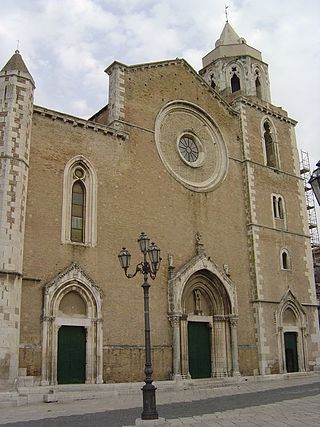
The Gotico Angioiano is a Gothic style of architecture found in southern Italy. It is named after the Capetian House of Anjou and had been the style of the Kingdom of Sicily since 1266 and the Kingdom of Naples since 1302. It must not be confused with the Angevin Gothic of western France. The Capetian House of Anjou began with Charles I of Anjou, who had been given the County of Anjou in apanage by his brother, Louis IX of France. He was given the kingdom of Sicily as a fief by Pope Clement IV, as the popes wanted to finish the Hohenstaufen rule in Italy and to cut the junctions between the Holy Roman Empire and Sicily. Establishing his rule in Naples, he brought a large staff of courtiers and specialists along with himself.





















